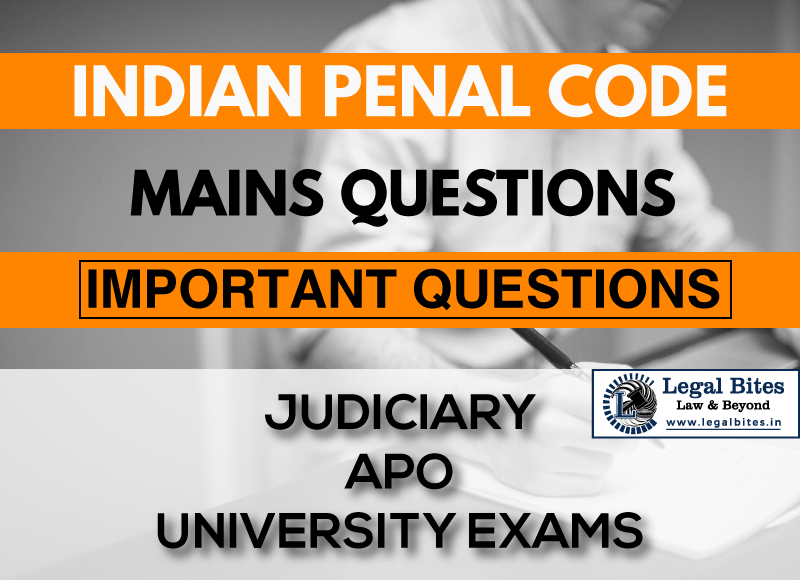‘A’ find that ‘B’, a feeble old woman, was stealing his crops. ‘A’ beat her so violently that she died on the spot. ‘A’ was prosecuted under Section 302, I.P.C for the murder of ‘B’.
Question: ‘A’ find that ‘B’, a feeble old woman, was stealing his crops. ‘A’ beat her so violently that she died on the spot. ‘A’ was prosecuted under Section 302, I.P.C for the murder of ‘B’. ‘A’ took the defence that he killed ‘B’ in the exercise of ‘right of private defence’. Is the defence of ‘A’ sustainable… Read More »

Question: ‘A’ find that ‘B’, a feeble old woman, was stealing his crops. ‘A’ beat her so violently that she died on the spot. ‘A’ was prosecuted under Section 302, I.P.C for the murder of ‘B’. ‘A’ took the defence that he killed ‘B’ in the exercise of ‘right of private defence’. Is the defence of ‘A’ sustainable at law? Give reasons and also refer to the relevant provision and case law, if any, on the point. Find the answer to the mains question only on...
Question: ‘A’ find that ‘B’, a feeble old woman, was stealing his crops. ‘A’ beat her so violently that she died on the spot. ‘A’ was prosecuted under Section 302, I.P.C for the murder of ‘B’. ‘A’ took the defence that he killed ‘B’ in the exercise of ‘right of private defence’. Is the defence of ‘A’ sustainable at law? Give reasons and also refer to the relevant provision and case law, if any, on the point.
Find the answer to the mains question only on Legal Bites. [‘A’ find that ‘B’, a feeble old woman was stealing his crops. ‘A’ beat her so violently that she died on the spot. ‘A’ was prosecuted under Section 302, I.P.C for the murder of ‘B’. ‘A’ took the defence that he killed ‘B’ in the exercise of ‘right of private defence’. Is the defence of ‘A’ sustainable at law? Give reasons and also refer to the relevant provision and case law, if any, on the point.
Answer
Some of the aspects of the right of private defence under the Indian Penal Code, 1860 are that no right of self-defence can exist against an unarmed and unoffending individual, the right is available against the aggressor only and it is only the person who is in imminent danger of person or property and only when no state helps is available. However, the most important principle is that the right of private defence requires that the force used in the defence should be necessary and reasonable in the circumstances. The reasonable apprehension can only be justified if the accused had an honest belief that there is danger and that such belief is reasonably warranted by the conduct of the aggressor and the surrounding circumstances.
Section 99 lays down the conditions and limits within which the right of private defence can be exercised. It restricts the right of private defence if there is time to seek the help of public authorities. And the right must be exercised in proportion to harm to be inflicted. The quantum of harm that may be caused shall in no case be in excess of harm that may be necessary for the purpose of defence. One suitable case law is of Mohinder Pal Jolly v. State Of Punjab[AIR 1979 SC 577.]. In this case, the workers of a factory threw brickbats from outside the gates, and the factory owned by a shot from his revolver caused the death of a worker, it was held that this section did not protect him, as there was no apprehension of death or grievous hurt.
The Supreme Court held in Jassa Singh v. State Of Haryana [2002 CrLJ 563(SC).] that the right of private defence of property would not extend to the causing of the death of the person who committed such acts if the act of trespass is in respect of open land. Only a house-trespass committed under such circumstances as may reasonably cause death or grievous hurt is enumerated as one of the offences under Section 103.
In the present case, A’ find that ‘B’, a feeble old woman, was stealing his crops. ‘A’ beat her so violently that she died on the spot. So, A here exceeded his right of private defence and has actually committed the offence of murder of B, and his defence is not sustainable at law.
Important Mains Questions Series for Judiciary, APO & University Exams
- IPC Mains Questions Series Part I: Important Questions
- IPC Mains Questions Series Part II: Important Questions
- IPC Mains Questions Series Part III: Important Questions
- IPC Mains Questions Series Part IV: Important Questions
- IPC Mains Questions Series Part V: Important Questions
- IPC Mains Questions Series Part VI: Important Questions
- IPC Mains Questions Series Part VII: Important Questions
- IPC Mains Questions Series Part VIII: Important Questions
- IPC Mains Questions Series Part IX: Important Questions
- IPC Mains Questions Series Part X: Important Questions
Admin Legal Bites
Legal Bites Study Materials correspond to what is taught in law schools and what is tested in competitive exams. It pledges to offer a competitive advantage, prepare for tests, and save a lot of money.

